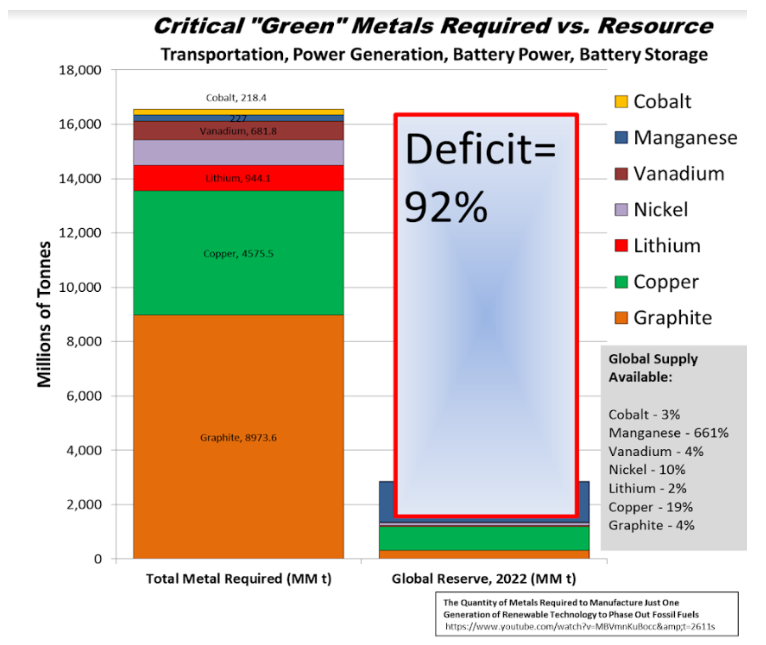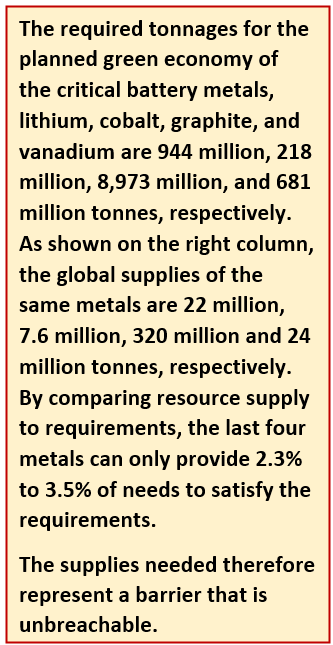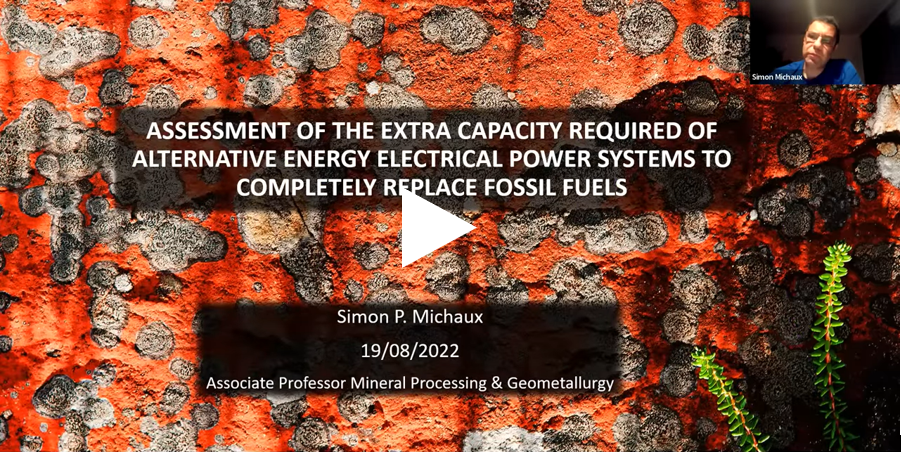
Cobalt Mine Opens in Idaho – Behind the scenes, the Biden administration is not friendly to mines or mining.
By David Boleneus, MBA, ME, geologist
I read and complemented Kylie Mohr on her recent High County News article that concerned the cobalt mine in Idaho. The mine just opened last week to begin to provide a supply of the metals cobalt and copper to build a clean energy economy. Adding to Kylie’s message I want to clarify realities about the related issues that she addresses. Major behind-the-scene conflicts are also at play that the Idaho mine has so far avoided. Here is Kylie’s article: Idaho cobalt mine is a harbinger of what’s to come
Kylie,
 I write concerning the excitement about green metals and the cobalt mine recently opened in Idaho. I want to report very bad news, however, concerning the metals and the green economy. The bad news concerns the supply of these metals, a factor that dictates and controls the United States’ ability to meet the demand expressed in plans by the President. In fact, this is really bad news that no one considers, not even Univ. of Nevada economic geologist, Simon Jowitt that Kylie cites. I too am an economic geologist with 5 decades experience in the industry including research positions with US Geological Survey and US Bureau of Mines, so I think it important to report on the issue of supply of the metals on a global basis, although not publicized, of these metals and ability of countries and economies to build these products using the metals needed that no one addresses and a rare few understand. I include an illustration below which I will use to explain.
I write concerning the excitement about green metals and the cobalt mine recently opened in Idaho. I want to report very bad news, however, concerning the metals and the green economy. The bad news concerns the supply of these metals, a factor that dictates and controls the United States’ ability to meet the demand expressed in plans by the President. In fact, this is really bad news that no one considers, not even Univ. of Nevada economic geologist, Simon Jowitt that Kylie cites. I too am an economic geologist with 5 decades experience in the industry including research positions with US Geological Survey and US Bureau of Mines, so I think it important to report on the issue of supply of the metals on a global basis, although not publicized, of these metals and ability of countries and economies to build these products using the metals needed that no one addresses and a rare few understand. I include an illustration below which I will use to explain.
The left column in the illustration with its many-colored bars depicts the quantities of each of the metals discussed (graphite, copper, lithium, nickel, vanadium, cobalt) as needed for transportation, power generation, battery power etc. These supplies are needed globally, with the need in the US about 40% of global but supplies in the US are much smaller than 40% of global. The largest quantities are needed for power generation, transportation and battery storage.
Take for example, copper, the most important industrial commodity in the world. The required copper for a green economy is 4,575 million tonnes of the metal, but the world supply, that is the known resource, identified but not yet mined is only 880 million tonnes. So, the supply can meet only 19% of what is needed. The required tonnages for the planned green economy of the critical battery metals, lithium, cobalt, graphite, and vanadium are 944 million, 218 million, 8,973 million, and 681 million tonnes, respectively. As shown on the right column, the global supplies of the same metals are 22 million, 7.6 million, 320 million and 24 million tonnes, respectively. By comparing resource supply to requirements, the last four metals can only provide 2.3% to 3.5% of needs to satisfy the requirements. The supplies needed therefore represent a barrier that is unbreachable.
1 Simon Michaux, geometallurgist, GTK, Finland Geological Survey

On the right column of the illustration the supply of these metals is revealed as I just listed. The colored blocks are quite smaller here, signifying how little is the supply of each metal. The supplies are far smaller than the need. Overall, the deficit or shortage to meet the need is 92%. That is, the global supply of metals can only supply 8% of needs up to exhaustion. This presumes that all supplies are directed to green energy which simply cannot happen as other customers, and other needs must be served by these supplies so the task to provide a supply is magnified. This explains the barrier to reaching green energy that has not been explained or addressed.
You might ask: Can we just mine more or find more to which I can answer yes, but not to meet the timeline politicians have set to be complete by 2040 or 2050, including the grand pronouncements for only electric cars will be available for sale by 2030 in Washington state or 2035 in California. Great effort is required here that is unappreciated and timelines cannot be compressed. Our current energy systems took 150 years to build, but today’s politicians want a new one in 15 years. As to finding new metals: For every 1000 deposits in which a metal is identified, only 1 or 2 become mines and it may take 20 years from discovery to opening a mine and for every 10 producing mines, 2 or 3 will lose money and shut down. Finding new metal deposits is very difficult.
In my experience it is immensely difficult and time consuming to locate a prospective area to explore and many years are required to evaluate the rock for their contents to see if it qualifies as ‘ore’ and then as to the economic conditions on mineralized terrains.
Hundreds of prospective areas are rejected but only after millions of dollars are spent, and thousands of personnel days without reward. It is a very difficult and immensely unappreciated job and requires great diligence and talent. Metal mining is an extremely cyclical business as prices of metals change abruptly, and investors are skittish and hard to find.
 Mining needs encouragement from the politicians but they provide the opposite. Behind the scenes, the Biden administration is not friendly to mines or mining. Biden just succeeded in preventing the Twin Metals mine in Minnesota from opening that would have produced both copper, nickel and cobalt, all of which are needed for new battery technology. Twin Metals is one of two potential mines than have been delayed for a variety of reasons.
Mining needs encouragement from the politicians but they provide the opposite. Behind the scenes, the Biden administration is not friendly to mines or mining. Biden just succeeded in preventing the Twin Metals mine in Minnesota from opening that would have produced both copper, nickel and cobalt, all of which are needed for new battery technology. Twin Metals is one of two potential mines than have been delayed for a variety of reasons.
What Biden did at Twin Metals is unprecedented in the USA. He cancelled, essentially confiscated the company’s property and its mining claims on National Forest land (although the article says leases). Such confiscation only happens in China, Russia, Venezuela, and Chile by dictators like Agusto Pinochet from former Third World Countries. The metals, copper, nickel and cobalt are classified as critical to the new energy economy by the US Government. The Inflation Reduction Act passed in August 2022 requires that all these metals come from sources and manufacturers in the U.S. So why the need for confiscation to prevent supply of a commodity in such demand? The US government is serving two purposes with each contradicting the other.
The effort by Biden continues, unabated. The Biden administration is today expending all possible efforts to block permitting of one copper mine in Alaska, (which could be the largest in the US, if opened) and also’ the permitting of two copper mines in Arizona. Washington state’s US Senator Maria Cantwell, successfully blocked permitting of a mine in Washington for 15 years in Okanogan County (the local community wanted the jobs) and in a second case more recently. The Senator was so aroused by a prospector wanting to explore for metals in the Cascade Mtns., she proposed to withdraw the explorers’s mining claims and convert them into wilderness to prevent the company from conducting core drilling as a first step to explore and identify new mineral resources.
Many states in the US are extremely unfriendly to mines, like Washington, California, Oregon and Montana, but less so in Utah and Idaho. The taxation and land acquisition requirement of/for mining is very unfriendly in the US compared to Canada’s or other countries in the Americas. There seems little or no determination to achieve a green economy, given when presented, by the effort to block supplies needed. The mining unfriendly states place unnecessary and unreasonable barriers to progress toward a green economy which each says is a key goal, yet little cooperation is afforded to industry play to reach this goal.
So now, one can see the barriers that combine to make it difficult to achieve a clean energy economy required by the US. Confiscation of property by the US government runs counter to the purpose.
Claims that we will become green and build great and massive machines to supply a green economy and transform to a new energy system likely will not happen without the needed inputs and cooperation of governments. Lack of government cooperation and supplies are unbreachable barriers. The inputs are the metal resources to make the ingredients, the manufactured products, and since these metals are not available the grand proclamations by the President, green activists and the Engineering and Mining Journal: Mining-media-international, September 2022 and others are just loose talk to serve another purpose but not meant to foster new energy resources.
It seems easy for expert observers to predict that all green plans will be abandoned. In time the barriers and high costs become more visible to more observers. And likely conflicts over supplies are unlikely to be resolved.
Data to support what I state is sourced from US Geological Survey, International Energy Agency, World Bank and Geological Survey of Finland.
To learn more, check out this video by Assoc Prof Simon Michaux – Sustainable Minerals Institute UQ: The quantity of metal required to make just one generation of renewable tech units to replace fossil fuels, is much larger than first thought.
